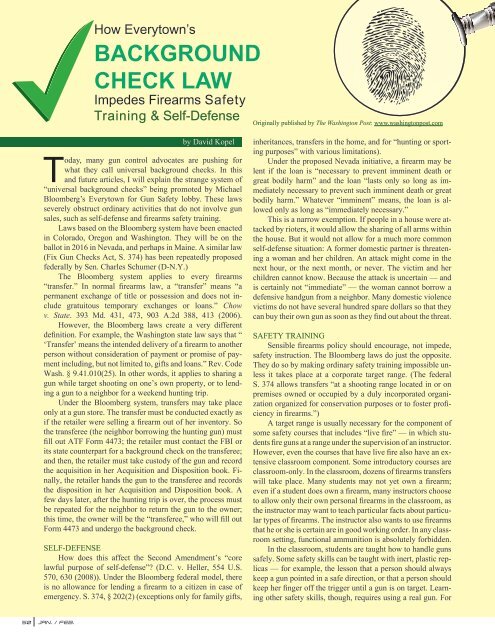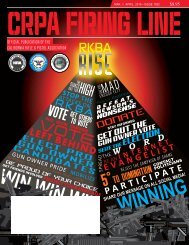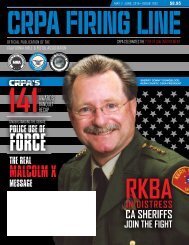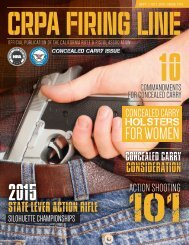CRPA Jan-Feb 2016
Create successful ePaper yourself
Turn your PDF publications into a flip-book with our unique Google optimized e-Paper software.
How Everytown’s<br />
BACKGROUND<br />
CHECK LAW<br />
Impedes Firearms Safety<br />
Training & Self-Defense Originally published by The Washington Post: www.washingtonpost.com<br />
by David Kopel<br />
Today, many gun control advocates are pushing for<br />
what they call universal background checks. In this<br />
and future articles, I will explain the strange system of<br />
“universal background checks” being promoted by Michael<br />
Bloomberg’s Everytown for Gun Safety lobby. These laws<br />
severely obstruct ordinary activities that do not involve gun<br />
sales, such as self-defense and firearms safety training.<br />
Laws based on the Bloomberg system have been enacted<br />
in Colorado, Oregon and Washington. They will be on the<br />
ballot in <strong>2016</strong> in Nevada, and perhaps in Maine. A similar law<br />
(Fix Gun Checks Act, S. 374) has been repeatedly proposed<br />
federally by Sen. Charles Schumer (D-N.Y.)<br />
The Bloomberg system applies to every firearms<br />
“transfer.” In normal firearms law, a “transfer” means “a<br />
permanent exchange of title or possession and does not include<br />
gratuitous temporary exchanges or loans.” Chow<br />
v. State. 393 Md. 431, 473, 903 A.2d 388, 413 (2006).<br />
However, the Bloomberg laws create a very different<br />
definition. For example, the Washington state law says that “<br />
‘Transfer’ means the intended delivery of a firearm to another<br />
person without consideration of payment or promise of payment<br />
including, but not limited to, gifts and loans.” Rev. Code<br />
Wash. § 9.41.010(25). In other words, it applies to sharing a<br />
gun while target shooting on one’s own property, or to lending<br />
a gun to a neighbor for a weekend hunting trip.<br />
Under the Bloomberg system, transfers may take place<br />
only at a gun store. The transfer must be conducted exactly as<br />
if the retailer were selling a firearm out of her inventory. So<br />
the transferee (the neighbor borrowing the hunting gun) must<br />
fill out ATF Form 4473; the retailer must contact the FBI or<br />
its state counterpart for a background check on the transferee;<br />
and then, the retailer must take custody of the gun and record<br />
the acquisition in her Acquisition and Disposition book. Finally,<br />
the retailer hands the gun to the transferee and records<br />
the disposition in her Acquisition and Disposition book. A<br />
few days later, after the hunting trip is over, the process must<br />
be repeated for the neighbor to return the gun to the owner;<br />
this time, the owner will be the “transferee,” who will fill out<br />
Form 4473 and undergo the background check.<br />
SELF-DEFENSE<br />
How does this affect the Second Amendment’s “core<br />
lawful purpose of self-defense”? (D.C. v. Heller, 554 U.S.<br />
570, 630 (2008)). Under the Bloomberg federal model, there<br />
is no allowance for lending a firearm to a citizen in case of<br />
emergency. S. 374, § 202(2) (exceptions only for family gifts,<br />
inheritances, transfers in the home, and for “hunting or sporting<br />
purposes” with various limitations).<br />
Under the proposed Nevada initiative, a firearm may be<br />
lent if the loan is “necessary to prevent imminent death or<br />
great bodily harm” and the loan “lasts only so long as immediately<br />
necessary to prevent such imminent death or great<br />
bodily harm.” Whatever “imminent” means, the loan is allowed<br />
only as long as “immediately necessary.”<br />
This is a narrow exemption. If people in a house were attacked<br />
by rioters, it would allow the sharing of all arms within<br />
the house. But it would not allow for a much more common<br />
self-defense situation: A former domestic partner is threatening<br />
a woman and her children. An attack might come in the<br />
next hour, or the next month, or never. The victim and her<br />
children cannot know. Because the attack is uncertain — and<br />
is certainly not “immediate” — the woman cannot borrow a<br />
defensive handgun from a neighbor. Many domestic violence<br />
victims do not have several hundred spare dollars so that they<br />
can buy their own gun as soon as they find out about the threat.<br />
SAFETY TRAINING<br />
Sensible firearms policy should encourage, not impede,<br />
safety instruction. The Bloomberg laws do just the opposite.<br />
They do so by making ordinary safety training impossible unless<br />
it takes place at a corporate target range. (The federal<br />
S. 374 allows transfers “at a shooting range located in or on<br />
premises owned or occupied by a duly incorporated organization<br />
organized for conservation purposes or to foster proficiency<br />
in firearms.”)<br />
A target range is usually necessary for the component of<br />
some safety courses that includes “live fire” — in which students<br />
fire guns at a range under the supervision of an instructor.<br />
However, even the courses that have live fire also have an extensive<br />
classroom component. Some introductory courses are<br />
classroom-only. In the classroom, dozens of firearms transfers<br />
will take place. Many students may not yet own a firearm;<br />
even if a student does own a firearm, many instructors choose<br />
to allow only their own personal firearms in the classroom, as<br />
the instructor may want to teach particular facts about particular<br />
types of firearms. The instructor also wants to use firearms<br />
that he or she is certain are in good working order. In any classroom<br />
setting, functional ammunition is absolutely forbidden.<br />
In the classroom, students are taught how to handle guns<br />
safely. Some safety skills can be taught with inert, plastic replicas<br />
— for example, the lesson that a person should always<br />
keep a gun pointed in a safe direction, or that a person should<br />
keep her finger off the trigger until a gun is on target. Learning<br />
other safety skills, though, requires using a real gun. For<br />
50<br />
JAN. / FEB.








